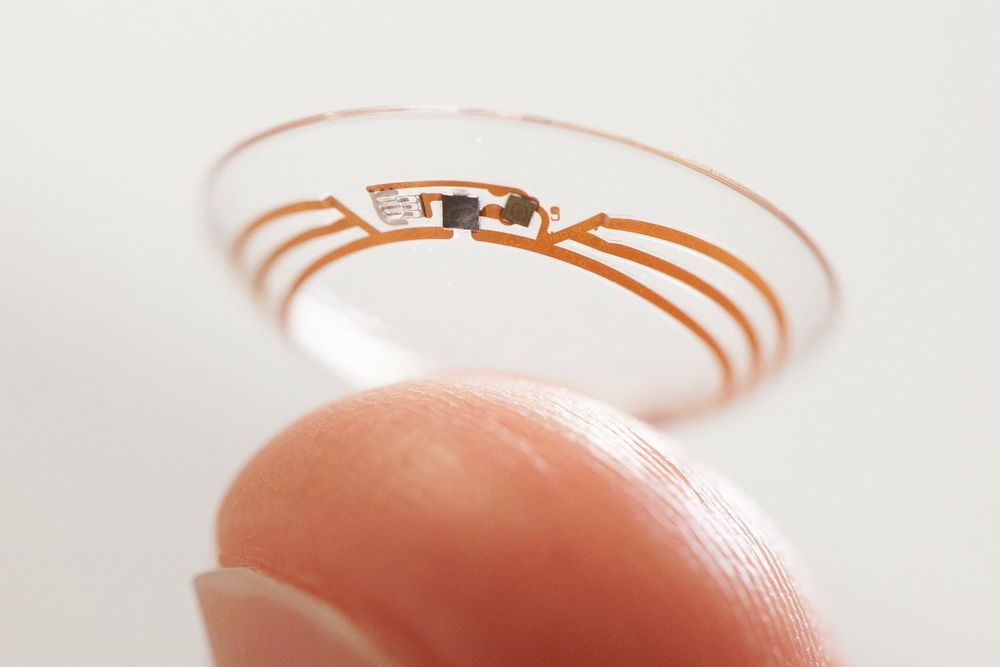A custom-made aerial drone delivered a kidney to a Baltimore hospital, where it was transplanted into a patient who had been on dialysis for eight years.
Category: biotech/medical – Page 2,305

Smart contacts: The future of the wearable you won’t even see
The notion of wearing lenses over our eyes to correct our vision dates back hundreds of years, with some even crediting Leonardo da Vinci as one of the first proponents of the idea (though that remains somewhat controversial). Material science and our understanding of the human eye have come a long way since, while their purpose has remained largely the same. In the age of wearable computers, however, scientists in the laboratories of DARPA, Google, and universities around the world see contact lenses not just as tools to improve our vision, but as opportunities to augment the human experience. But how? And why?
As a soft, transparent disc of plastic and silicone that you wear on your eyeball, a contact lens may seem like a very bad place to put electronics. But if you look beneath the surface, the idea of a smart contact lens has real merit, and that begins with its potential to improve our well-being.

‘Doughnut-Shaped’ DNA Makes Cancer More Aggressive
Cancer cells may owe some of their destructive nature to unique, “doughnut-shaped” DNA, according to a new study.
The study, published today (Nov. 20) in the journal Nature, found that, in some cancer cells, DNA doesn’t pack into thread-like structures like it does in healthy cells — rather, the genetic material folds into a ring-like shape that makes the cancer more aggressive.
Michael Rose — Hierarchies of Replication Necessary for Life Sciencing
Bursts of media coverage of retracted scientific articles and failures to replicate and reproduce scientific findings have led to a widespread sense of crisis in the familiar forms of scientific knowledge production and communication. Is the language of crisis warranted, or is this how science has always worked? How are technological changes in the communication of scientific results affecting the process of scientific knowledge production? Are there genuine knowledge crises in certain scientific fields (such as medicine or social science)? What solutions are available for these problems, and how can new scholars move forward with both confidence and integrity in this environment?
This program will be appropriate to all campus personnel and community members interested in how the process of scientific communication may affect their role as producers and consumers of scientific knowledge.

University of Miami Researcher Develops Stem Cell Harvesting Technology
A University of Miami doctor says he can rebuild a whole jaw using new stem cell collection technology.
Known as the “MarrowMarxman”, the FDA-registered device was developed and tested by Dr. Robert Marx, who is a professor and chief of the Division of Oral and Maxillofacial Surgery at the University of Miami Miller School of Medicine.
Hope4Cancer Treatment Centers announces Eight Days
…Hope4Cancer Treatment Centers™ announces Eight Days, a groundbreaking reality TV series that tells the stories of five cancer patients and their journey using alternative cancer treatments that are working. The first reality TV series of its kind, Eight Days, is set to premiere on the FYI Television Network on January 4, 2020 and will give viewers an inside look at what healing from cancer is really like, as well as highlight new integrative cancer treatment options.
Everyone is getting excited to watch this life-changing series! For more information about 8 Days visit our website at https://hope4cancer.com/8-days-season-2/.

Encouraging early results from first human CRISPR gene therapy trials
Promising preliminary data from one of the first human trials testing the safety and efficacy of a CRISPR gene therapy has just been revealed. Although it is too early to evaluate long-term effects, the initial reports are impressively successful for two patients with severe genetic blood diseases.
Until February of this year, when pharmaceutical companies CRISPR Therapeutics and Vertex began a large global trial into a treatment called CTX001, no human outside of China had been officially treated with a CRISPR-based gene editing therapy.
CTX001 was developed to treat two types of inherited blood disease, beta-thalassemia and sickle cell disease. Both conditions are caused by a mutation in a single gene and the treatment involves engineering a patient’s stem cells with a single genetic change designed to raise levels of fetal hemoglobin in red blood cells.

Yogurt and fiber diet may cut lung cancer risk
“This inverse association was robust, consistently seen across current, past, and never smokers, as well as men, women, and individuals with different backgrounds,” she adds.
Shu says the health benefits may be rooted in their prebiotic (nondigestible food that promotes growth of beneficial microorganisms in the intestines) and probiotic properties. The properties may independently or synergistically modulate gut microbiota in a beneficial way.
The research appears in JAMA Oncology. Additional coauthors are from Seoul National University and Vanderbilt.

Rejuvenation: If I could turn back time … — Longevity.Technology
Last week, the BBC reported on the plight of axolotls in Mexico City, which are under threat of extinction. [1] The risk to these creatures is made doubly concerning when you consider their incredible ability to regenerate and apparent immunity to cancer, which is of great interest to scientists and companies working in the Longevity sector. One such company is Bioquark, a Philadelphia-based life sciences company that is working on the development of combinatorial biologics for the rejuvenation and repair of human organs and tissues. Among its clinical plans, it lists the development of therapeutic products for cancer reversion, organ repair and regeneration, and even brain death resuscitation. Nothing major then!
Bioquark has developed a novel combinatorial biologic called BQ-A, which mimics the regulatory biochemistry of the living human egg (oocyte) immediately following fertilization. While ooplasm-based reprogramming has been studied in experiments such as in-vitro fertilization and cloning, Bioquark claims it is the first company to apply it to somatic tissue in mammals.
We spoke with Bioquark’s CEO, Ira Pastor, a 30-year veteran of the pharmaceutical industry, to find out more about the company and where it’s headed.

Special immune cells found in people aged 110+ are rare in the young
Statistically, it’s unlikely that most of us will ever reach our 110th birthday, so scientists are fascinated by those few that do. In a new study, researchers looked at the immune systems of people who have hit the milestone, and found that they have a high number of a particular type of immune cell that’s rare even in healthy, younger people.
Even in our world of modern medicine, supercentenarians (people over the age of 110) are extremely rare, with estimates saying there are less than 1,000 such people worldwide. Perhaps not surprisingly, previous studies have shown that people who make it to 110 years old generally seem to avoid illnesses like cancer or infections throughout their whole lifetimes.
So for the new study, researchers at the RIKEN Center for Integrative Medical Science (IMS) and Keio University set out to examine the immune systems of supercentenarians and compare them to younger people. They took over 40,000 cells from seven supercentenarian subjects, and about 20,000 cells from five control subjects, aged in their 50s to 80s.